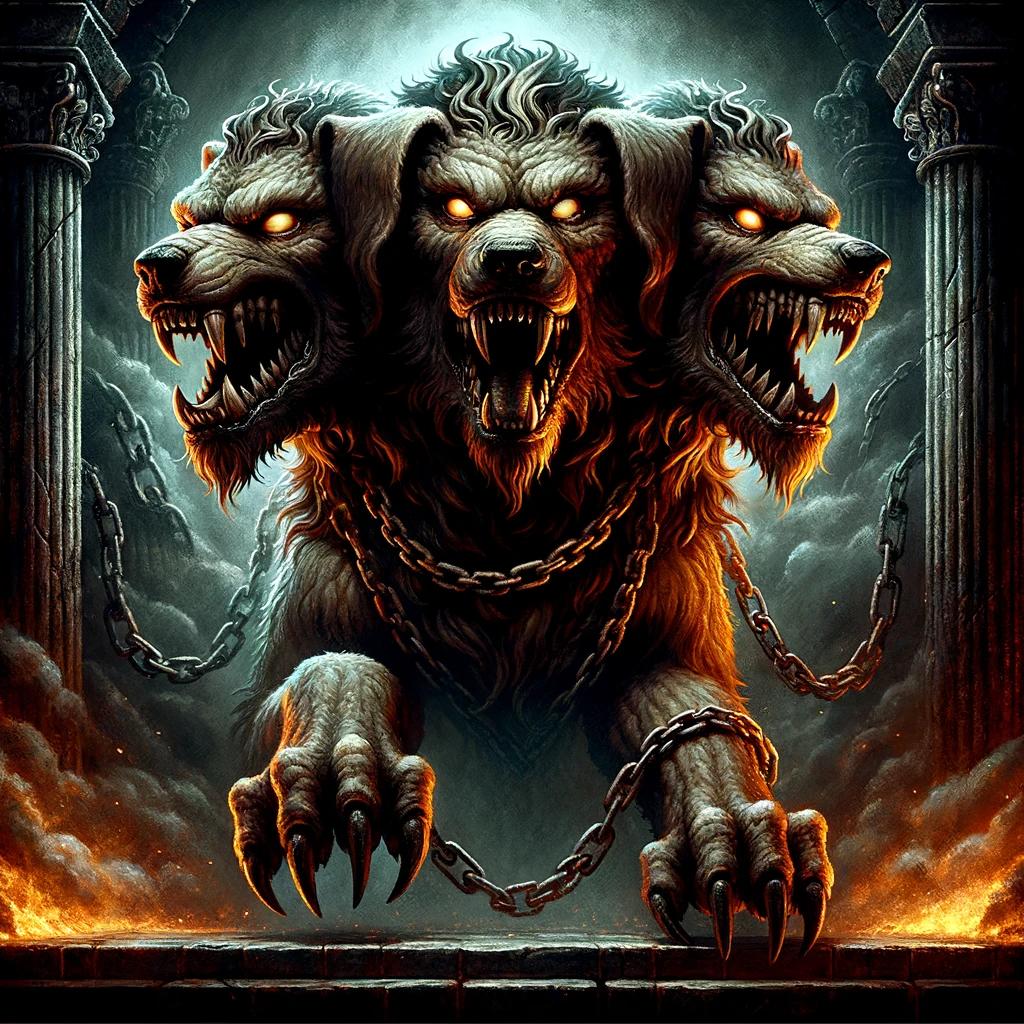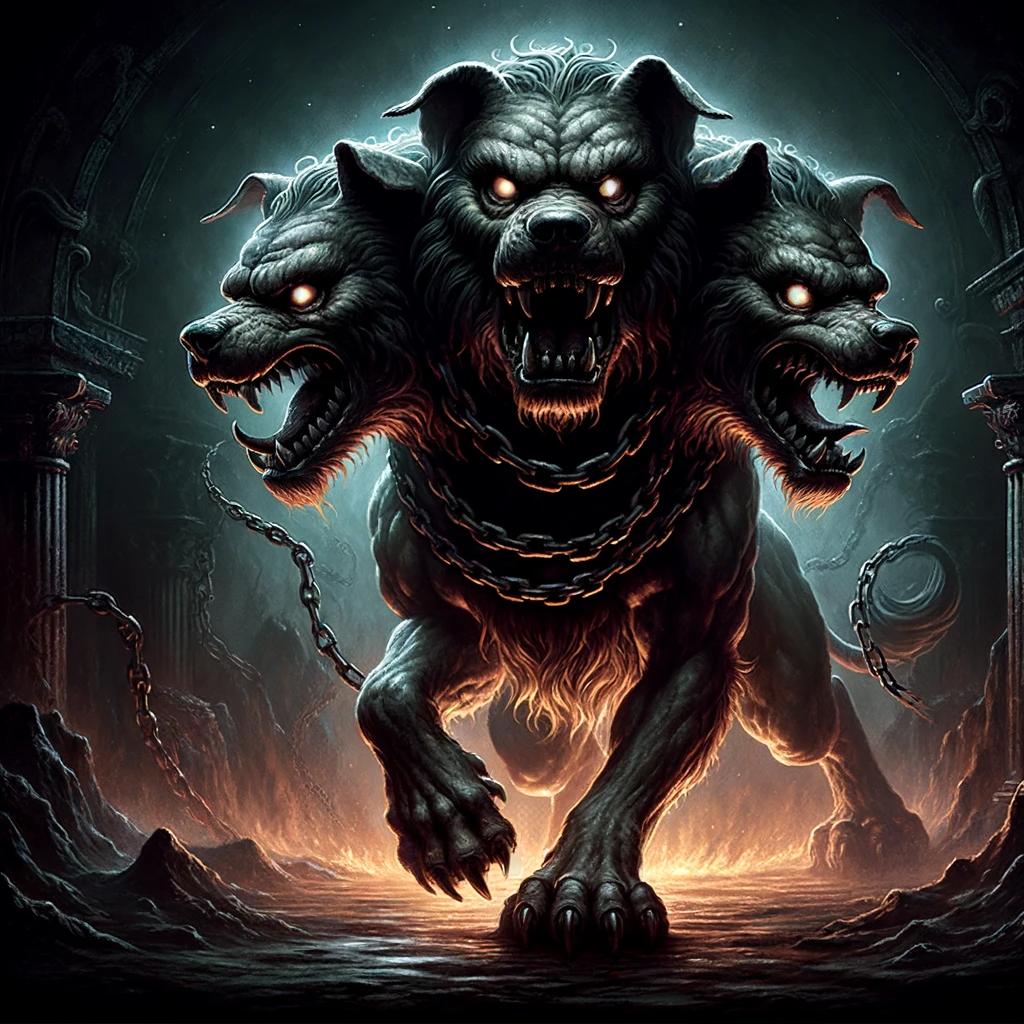Cerberus: Guardian of the Underworld

Cerberus, a fearsome three-headed dog from Greek mythology, is known as the guardian of the underworld, often depicted with his massive form looming over the realm of Hades. Descended from the monsters Echidna and Typhon, Cerberus possesses a serpent tail and snakes emerging from its body, a testament to his formidable lineage and his role as the three-headed dog in Greek mythology.
While some sources mention variations in the number of heads, most representations show three heads, symbolizing his ability to see the past, present, and future. Cerberus is tasked with devouring those who try to escape Hades, the god of the underworld, and preventing the living from entering.
This role as Hades’ dog solidifies his place in the pantheon of Greek mythology as a guardian not just of the underworld, but also of the secrets and mysteries held within.
This three-headed dog, often referred to as “what is Cerberus?” in myths, plays a pivotal role in Greek mythology, embodying the concept of an insurmountable barrier between the underworld and the earth, a guardian at the threshold between life and death.
One notable story involves the capture of Cerberus by Heracles (Hercules Furens), as part of his twelfth labor, a task that highlights the hero’s strength and cunning.
Aided by Hermes, Athena, and the enchanting music of Orpheus, Heracles was able to subdue Cerberus and bring him back from the underworld, showcasing the bond between Cerberus and the underworld and his role as a formidable obstacle even for heroes.
Origins of Cerberus in Greek Mythology
The origins of Cerberus, the legendary three headed dog of Greek mythology, can be traced back to its fearsome lineage. According to ancient tales, Cerberus is the offspring of Echidna, a monstrous half-woman half-serpent creature, and Typhon, a powerful and monstrous giant.
This unholy union resulted in the creation of a creature that embodied terror and darkness, marking what is a Cerberus as not just any mythical creature but a unique symbol of guardianship and terror in Greek mythology.
The place where Cerberus stands, guarding the entrance to the underworld, is pivotal in Greek mythology, serving as the threshold from the dead to the world of the living, ensuring that the balance between the two realms remains intact.
Descendants of Echidna and Typhon
The Greek three-headed dog Cerberus inherited its terrifying traits from its parents, Echidna and Typhon. Echidna was known as the “Mother of All Monsters” and was associated with various monstrous creatures of Greek mythology.
He was described as having multiple heads, fire-breathing nostrils, and a serpentine lower body.
As the child of these monstrous beings, Cerberus inherited their ferocity and monstrous attributes, further solidifying his role and clarifying that, while is Cerberus a god might be a common question, he is more accurately described as the guardian of the underworld’s gates rather than a deity.
This lineage places Cerberus among the most famous offspring of Typhon and Echidna, alongside other legendary creatures like the Hydra, Medusa, Minotaur, Nemean Lion, and the Erinyes (Furies).
Cerberus’ Physical Description
Cerberus, often recognized as the greek three-headed dog, is widely depicted as a fearsome three-headed dog with a tail resembling that of a serpent, symbolizing his vigilance and deadly power.
Each of its heads had a row of sharp teeth, and its eyes glowed with an eerie intensity, making Cerberus not just a guardian but also the hound of Hades.
Its immense size surpassed that of an ordinary dog, adding to its menacing presence. The three heads with their vigilant eyes act as a deterrent that guarded the entrance to the underworld, embodying the multifaceted nature of Cerberus’ role as a protector and gatekeeper.
Three Heads and Serpent Tail
One of the defining features of Cerberus is its three heads, which were said to possess incredible vigilance and awareness. The heads acted independently, making it difficult for anyone to approach or escape undetected, each head and mind focused on the security of the underworld’s gates.
Additionally, Cerberus had a long, serpent-like tail, capable of striking with deadly force, embodying the three-headed dog greek mythology icon. This feature, along with the snakes that emerged from its body, contributed to Cerberus’ image as a multi-headed monster.
Cerberus’ terrifying appearance extended beyond its three heads and serpent tail. Snakes were said to emerge from various parts of its body, adding an extra layer of dread and symbolism.
Variations in the Number of Heads
These three heads represented the multi-dimensional nature of the underworld, guarding its gates from intruders and symbolizing who is Cerberus in Greek mythology: a formidable guardian against any who dare to trespass.
By exploring the origins and physical characteristics of Cerberus, we gain a deeper understanding of the fearsome creature that stood as the guardian of the underworld in Greek mythology.
Who is Cerberus, with his daunting presence and role, signifies the complex nature of ancient myths and their capacity to convey themes of protection, boundary, and the transition between worlds.
Cerberus’ Role in Greek Mythology
Cerberus, the formidable three-headed guardian of the underworld, plays a significant role in Greek mythology. Often referred to as the cerberus dog, his presence at the gates of the underworld was not just as a deterrent but also as a symbol of the impenetrable barrier between the living and the dead, highlighting the transition where the realms of life and death intersect.
His role in Cerberus world history is not just about keeping the dead from escaping, but also about embodying the fears and beliefs of ancient societies regarding the afterlife.
Let’s delve into the key aspects of Cerberus’ role, exploring how this three-headed dog in Greek mythology figure has captivated imaginations and conveyed the ancient Greeks’ beliefs about death, the afterlife, and the necessity of guarding the most sacred of thresholds.
It’s believed that Cerberus was directly descended from the Greek monsters Echidna and Typhon, symbolizing his deep roots in the mythological traditions of both Greek and Roman cultures.
Guardian of the Underworld
Cerberus stands as the fearsome sentinel at the gates of the underworld, ensuring that no living soul crosses into the realm of Hades. Often referred to as “Hades’ dog,” its sheer presence instills terror and serves as a deterrent to those seeking unauthorized entry, a task that echoes through the tales of the Iliad and the adventures of Heracles, emphasizing the unyielding nature of this guardian.
Despite common queries, is Cerberus a Greek god, it’s more accurate to describe Cerberus as a divine guardian rather than a deity himself. This role that guarded the entrance to the underworld according to ancient texts, places Cerberus among the most iconic creatures of mythology, a testament to his enduring legacy in the stories of Homer’s Iliad and beyond.
Devourer of Escaping Souls
Cerberus carries out its grim duty of devouring any unfortunate souls who attempt to escape from the clutches of the underworld. With its ferocious appetite, it ensures that those who have been condemned to Hades remain trapped within its realms, embodying the concept of a three-headed dog mythology that is unique to Greek lore.
This depiction is derived from the Greek word ‘kerberos’ meaning guardian of the pit, further emphasizing that Cerberus had three heads, each playing a vital role in the underworld’s defense.
Prohibition of Entry to the Living
Not only does Cerberus prevent escape from the underworld, but it also prohibits the living from entering. Its imposing stature and menacing nature serve as a formidable barrier, allowing only the deceased to pass into the realm of the dead.
This greek mythology three-headed dog symbolizes the ultimate boundary between life and death, a boundary initiated into the fabric of myth by ancient storytellers, including Homer in The Iliad.
As we explore the multifaceted role played by Cerberus, it becomes evident that its guardianship and insatiable appetite for souls embody the pervasive power and relentless authority of the underworld.
The name “Cerberus” itself, often misspelled as “cerebus” or “ceberus,” has become synonymous with gatekeeping and protection in the context of ancient mythology, solidifying its status as the most famous headed dog that guards the realm of Hades.
The Capture of Cerberus by Heracles
The capture of Cerberus by Heracles was the twelfth and final labor assigned to the hero, showcasing the immense challenge and danger involved in confronting the guardian of the underworld.
This monumental task, the twelfth and final test set by King Eurystheus, required Heracles to venture into the underworld and bring Cerberus was brought back to the living world, an act that demonstrated his unparalleled strength and valor.
Heracles’ Twelfth Labor
Heracles’ twelfth labor, the capture of the three-headed Cerberus, was a testament to his heroic qualities and determination. King Eurystheus had set this impossible task to test the hero’s strength and bravery.
Determined to succeed, Heracles embarked on his perilous journey to the underworld, fully aware of the dangers that awaited him and the significance of capturing Cerberus, the three-headed dog in Greek mythology, in the grand narrative of Greek mythology.
Initiation into the Eleusinian Mysteries
Before descending to the realm of the dead, Heracles underwent initiation into the sacred rituals of the Eleusinian Mysteries. These mysteries, which involved deities such as Athena, Demeter, Dionysus, and Hephaestus, offered him spiritual purification, enlightenment, and the favor of the gods, equipping him with the knowledge to safely navigate the underworld and confront Cerberus, the Greek three-headed dog.
Assistance from Hermes and Athena
Guided by Hermes, the messenger of the gods, and Athena, the goddess of wisdom, Heracles received invaluable aid on his quest. Their divine assistance was crucial in helping him confront Cerberus, the guardian of the underworld, known in some texts as the Greek god Cerberus.
This support underscores the collaborative effort between Heracles and Cerberus, as well as the hero’s reliance on divine support to achieve his daunting task.
Cerberus’ Enchantment by Orpheus
As Heracles encountered Cerberus, he was met with fierce resistance. However, his journey through the underworld had also led him to the talented musician Orpheus. With his enchanting melodies, Orpheus managed to soothe the beast, Cerberus, the three-headed dog Greek mythology has often depicted as ferocious yet susceptible to the arts, allowing Heracles to approach and successfully overpower the mighty guardian of the underworld.
This creature, called the hound of Hades, guarded the cattle of the dead and was a formidable opponent even for a hero aided by Hermes and divine intervention.
Interpretations of Cerberus’ Name
One fascinating aspect of Cerberus, the fearsome guardian of the underworld, is the uncertainty surrounding the origin and meaning of its name.
Scholars have proposed various interpretations, but no consensus has been reached, sparking debate about what does Cerberus mean.
Uncertain Etymology
The etymology of Cerberus’ name remains a subject of debate. Attempts to establish an Indo-European origin have been unsuccessful, leading to exploration of other possibilities, including its representation as a headed dog in Greek mythology.
Some suggest the name derives from the Greek word “kerberos,” hinting at its role as a guardian.
Proposed Greek Etymologies
Several Greek etymologies have been proposed, shedding light on potential meanings associated with Cerberus’ name and its significance in Cerberus Greek mythology. These interpretations offer a deeper insight into the mythology of Cerberus, emphasizing its role as the three-headed dog that guards the threshold between the living and the dead, a motif echoed in various Greek mythology dog with similar guardian roles.
‘Creoboros’ – Devourer of Flesh
One suggestion is that Cerberus’ name may be linked to the Greek term ‘creoboros,’ which translates to ‘devourer of flesh.’ This interpretation aligns with Cerberus’ role in consuming lost souls attempting to escape the realm of Hades. The three dog heads of Cerberus were believed to prevent souls from his domain from leaving without permission, embodying the terrifying nature as a guardian of the underworld.
‘Ker berethrou’ – Mal of the Well
Another proposed etymology connects Cerberus’ name to ‘Ker berethrou,’ meaning ‘mal of the well.’ This interpretation possibly alludes to Cerberus’ position as a terrifying guard stationed near the entrance to the underworld.
It underscores the idea that Cerberus was not just a creature of myth but also a significant symbol of the underworld according to ancient beliefs, acting as a formidable barrier along with the Erinyes (Furies).
While the exact etymology of Cerberus’ name remains elusive, these suggested interpretations offer insights into the complex nature and symbolism associated with this mythological creature, commonly referred to as the Greek god Cerberus.
The cerberus, with its heads Greek mythology often depicts along with snakes and other terrifying features, has cemented its place in the lore of the ancient world.
Cerberus’ Influence in Mythology and Culture
Representation of the Underworld
Cerberus, the infamous three-headed dog of Greek mythology, has left a significant impact on the representation of the underworld.
Its imposing presence has been depicted in various forms of art, literature, and even in modern pop culture, embodying the greek three-headed dog‘s role as a formidable barrier to the afterlife.
Cerberus stands as a symbol of the fearsome guardian that prevents living beings from entering the realm of the dead. Its portrayal often emphasizes its ferocity, with its multiple heads, serpent tail, and snakes emanating from its body, terrifying all who behold it.
This is a testament to three-headed dog Greek mythology, where Cerberus is seen as a multi-headed creature with the ability to instill fear in both mortals and immortals alike.
Through its representation, Cerberus adds depth and realism to the mythical realm of the underworld, cementing its status as a headed dog in Greek mythology.
Cerberus dog Greek mythology intertwines the son of Typhon and Echidna with the narrative fabric of the ancient world. The Cerberus and the other creatures from myths such as the Minotaur, Nemean Lion, and more, were all part of the fascinating tapestry of ancient storytelling that was brought to all and exhibited in the tales of heroes and gods.
Significance in Art and Literature
Throughout history, Cerberus’ image has served as inspiration for countless artists and writers. Its appearance in ancient Greek pottery and sculptures demonstrates the cultural significance attached to this mythological creature. In literature, Cerberus plays a pivotal role in various myths and epic tales, captivating audiences with stories of its capture, guard duty, and encounters with mythological heroes such as Heracles. Heracles’ twelfth labour carried him away to confront Cerberus and and exhibited him as a symbol of conquering death.
Mythology Cerberus has transcended time, continuing to be a source of fascination for his unique place in Greek mythology Cerberus dog narratives.
Cerberus’ Influence in Mythology and Culture
Representation of the Underworld
Cerberus, the infamous three-headed dog of Greek mythology, has left a significant impact on the representation of the underworld. Its imposing presence has been depicted in various forms of art, literature, and even in modern pop culture, embodying the greek three-headed dog‘s role as a formidable barrier to the afterlife.
Legend has it that Cerberus, with his brazen voiced bark, could terrify even the bravest of souls near the gates of the underworld, warning them of the perils that lay ahead.
Cerberus stands as a symbol of the fearsome guardian that prevents living beings from entering the realm of the dead. Its portrayal often emphasizes its ferocity, with its multiple heads, serpent tail, and snakes emanating from its body, terrifying all who behold it.
This is a testament to three-headed dog Greek mythology, where Cerberus is seen as a multi-headed creature with the ability to instill fear in both mortals and immortals alike.
Through its representation, Cerberus adds depth and realism to the mythical realm of the underworld, cementing its status as a headed dog in Greek mythology.
Cerberus dog Greek mythology intertwines the son of Typhon and Echidna with the narrative fabric of the ancient world. The Cerberus and the other creatures from myths such as the Minotaur, Nemean Lion, and more, were all part of the fascinating tapestry of ancient storytelling that was brought to all and exhibited in the tales of heroes and gods.
Significance in Art and Literature
Throughout history, Cerberus’ image has served as inspiration for countless artists and writers. Its appearance in ancient Greek pottery and sculptures demonstrates the cultural significance attached to this mythological creature. In literature, Cerberus plays a pivotal role in various myths and epic tales, captivating audiences with stories of its capture, guard duty, and encounters with mythological heroes such as Heracles. Heracles’ twelfth labour carried him away to confront Cerberus and and exhibited him as a symbol of conquering death.
Mythology Cerberus has transcended time, continuing to be a source of fascination for his unique place in Greek mythology Cerberus dog narratives.
Its menacing presence and unrestrained power make it a captivating subject for creative interpretations, illustrating the three-headed dog Greek mythology has immortalized in its lore.
Heracles was sent to capture Cerberus as part of his labors, a task that highlights the creature’s formidable nature and its role as the guardian that guards the entrance to the underworld.
This mythological three-headed dog, often referred to as the dog with three heads, serves as a potent symbol of the boundary between the living and the dead.
In addition, Cerberus’ influence extends beyond ancient mythology and artistic expression.
Its imagery has permeated popular culture, appearing in books, films, and video games, where its depiction often stays true to its Greek roots. The enduring fascination with Cerberus serves as a testament to its iconic status and the lasting impression it has left on human imagination.
This is evident in how the myth writers of our time continue to draw upon Cerberus’ imagery to evoke the liminal space between the living and those from the dead. The Cerberus physical description in these tales often emphasizes its role as a three-headed dog god, underscoring Cerberus symbolism in the mythic tradition.
Overall, Cerberus’ influence in mythology and culture is undeniable. Its representation in the underworld and its significance in art, literature, and popular culture have secured its place as one of the most recognizable and feared creatures from Greek mythology.
This role was the twelfth labor assigned to Heracles, highlighting the creature’s significant place in Cerberus’ world history and mythology. Cerebus Greek mythology, despite the common misspelling, continues to captivate those exploring the depths of ancient stories.
Unquestionably, Cerberus’ impact on Greek mythology and its enduring legacy in various forms of artistic expression make it a captivating subject of exploration and inspiration. Through its representation, Cerberus invokes a sense of awe, fear, and fascination, reminding us of the rich tapestry of Greek mythology and its timeless influence on our cultural heritage.
The place where Cerberus stands guard, preventing souls from the dead from leaving and the living from entering without permission, underscores the belief the gods said about the sanctity and separation of the worlds of the living and the dead.
Its characteristic of having three heads symbolizes its vigilance and the comprehensive scope of its guardianship over the underworld. What is the Cerberus but a testament to the imagination and theological concepts of ancient Greece, reflecting themes of protection, transition, and the inexorable nature of death.
.




















